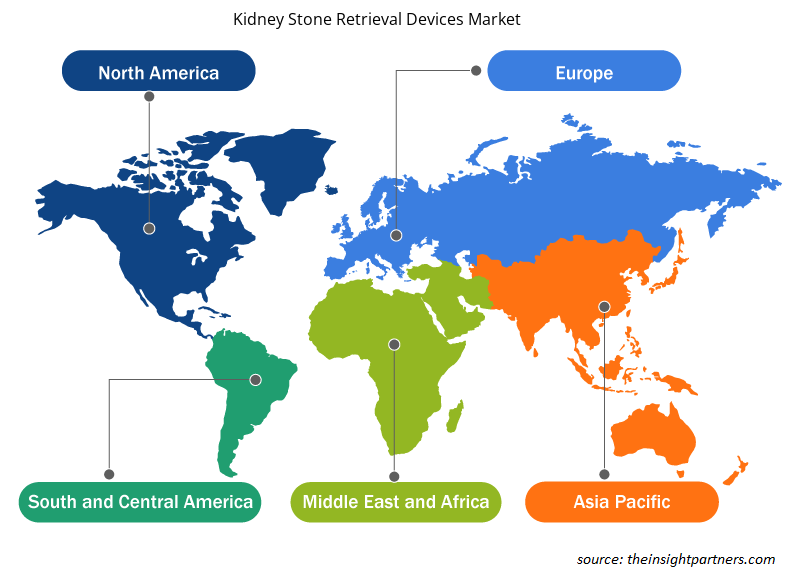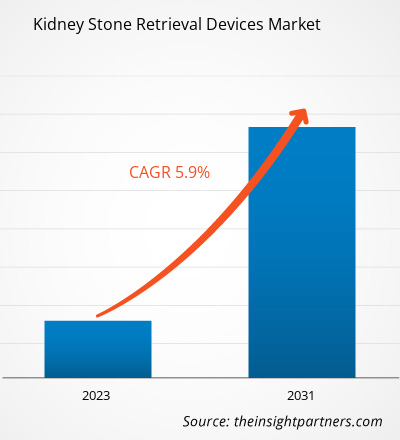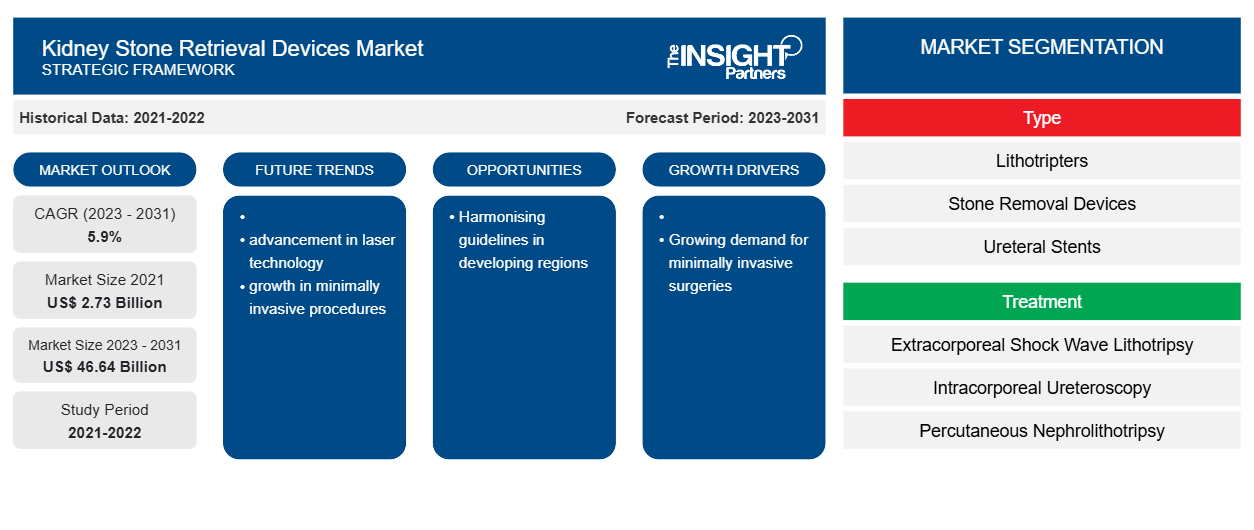El tamaño del mercado de dispositivos de recuperación de cálculos renales se estimó en US$ 2.73 mil millones en 2021 y US$ XX mil millones en 2023 y se espera que alcance los US$ 46.64 mil millones para 2031; se estima que registrará una CAGR de 5.9% hasta 2031. Es probable que la preferencia por las cirugías robóticas para enfermedades renales siga siendo una tendencia clave del mercado de dispositivos de recuperación de cálculos renales.
Análisis del mercado de dispositivos para la extracción de cálculos renales
El lanzamiento de este producto cataliza en gran medida el crecimiento del mercado de dispositivos para la recuperación de cálculos renales. Las empresas se están centrando ampliamente en el desarrollo de dispositivos que se utilizan para realizar procedimientos quirúrgicos mínimamente invasivos. Por ejemplo, en enero de 2023, Boston Scientific lanzó el dispositivo de despliegue de recuperación LithoVue Empower en EE. UU. y Europa. El dispositivo se utiliza para la recuperación de cálculos renales mediante ureteroscopia flexible (URS) y está indicado para su uso con el ureteroscopio flexible digital de un solo uso LithoVue y la cesta de recuperación de nitinol compatible. El dispositivo permite el funcionamiento simultáneo de un ureteroscopio y una cesta. Los avances tecnológicos del producto simplifican los procedimientos y ayudan a recoger y extraer el cálculo. Estos procedimientos mínimamente invasivos se están adoptando ampliamente para recuperar cálculos renales de personas mayores. Los dispositivos utilizados en estos procedimientos reducen el tiempo necesario para la cirugía y la duración de la estancia hospitalaria, además de permitir una recuperación rápida.
Descripción general del mercado de dispositivos para la recuperación de cálculos renales
El mercado mundial de dispositivos de recuperación de cálculos renales está segmentado por región en América del Norte, Europa, Asia Pacífico, Oriente Medio y África, y América del Sur y Central. La región de América del Norte tiene la mayor participación de mercado, mientras que la región de Asia Pacífico es la región de más rápido crecimiento. El crecimiento en América del Norte está determinado por la creciente incidencia de cálculos renales en todos los países, el aumento del gasto en atención médica para enfermedades renales crónicas y el aumento del apoyo gubernamental mediante la introducción de pautas para tratar los cálculos renales. Por otro lado, se espera que la falta de experiencia necesaria para los procedimientos mínimamente invasivos obstaculice el crecimiento del mercado.
Personalice este informe según sus necesidades
Obtendrá personalización en cualquier informe, sin cargo, incluidas partes de este informe o análisis a nivel de país, paquete de datos de Excel, así como también grandes ofertas y descuentos para empresas emergentes y universidades.
-
Obtenga las principales tendencias clave del mercado de este informe.Esta muestra GRATUITA incluirá análisis de datos, desde tendencias del mercado hasta estimaciones y pronósticos.
Impulsores y oportunidades del mercado de dispositivos para la extracción de cálculos renales
Creciente demanda de cirugías mínimamente invasivas favorecerá mercado
Con el paso del tiempo, se ha producido un aumento significativo de la prevalencia de enfermedades renales, lo que ha dado lugar a un aumento de los procedimientos quirúrgicos. Los procedimientos quirúrgicos invasivos tienen altos factores de riesgo y los pacientes tardan más tiempo en recuperarse. Estos procedimientos tienen un alto riesgo de infecciones y una alta tasa de complicaciones a nivel mundial. Para superar las consecuencias asociadas a los procedimientos invasivos, los profesionales sanitarios prefieren los procedimientos mínimamente invasivos. Los profesionales sanitarios se inclinan más por los procedimientos mínimamente invasivos debido a varias ventajas, como períodos de recuperación más cortos, complicaciones muy limitadas o nulas, altas tasas de éxito y reducción del tiempo del procedimiento. En los últimos años, la cirugía mínimamente invasiva se ha vuelto cada vez más popular para tratar los cálculos del tracto urinario superior. La Asociación Europea de Urología recomienda tanto la nefrolitotomía percutánea (PCNL) como la cirugía intrarrenal retrógrada (RIRS) para los cálculos con un diámetro inferior a 2 cm. La PCNL es la primera opción para los cálculos con un diámetro superior a 2 cm. Con el avance de los instrumentos endoscópicos y la tecnología mínimamente invasiva, la PCNL tradicional ha evolucionado hacia la Mini-PCNL, Ultra-mini PCNL, Super-mini PCNL, Micro-pcnl y otros procedimientos mínimamente invasivos. Además, un aumento en los procedimientos mínimamente invasivos condujo al lanzamiento de productos y al desarrollo de instrumentos especializados que ayudan durante la cirugía. Los resultados positivos de las cirugías mínimamente invasivas han aumentado la inclinación hacia las cirugías mínimamente invasivas para los cálculos renales, ya que los actores del mercado se centran en el desarrollo y lanzamiento de productos avanzados. percutaneous nephrolithotomy (PCNL) and retrograde intrarenal surgery (RIRS) for stones with a diameter less than 2 cm. PCNL is the first choice for stones with a diameter greater than 2 cm. With the advancement of endoscopic instruments and minimally invasive technology, traditional PCNL has evolved into Mini-PCNL, Ultra-mini PCNL, Super-mini PCNL, Micro-pcnl, and other minimally invasive procedures. Additionally, an increase in minimally invasive procedures led to product launches and development of specialized instruments that help during the surgery. The positive outcomes of minimally invasive surgeries have increased the inclination toward minimally invasive kidney stone surgeries as market players are focused on development and launch of advanced products.
Armonización de las directrices para la extracción de cálculos renales en regiones en desarrollo: una oportunidad
Se espera que la armonización de las directrices para los procedimientos de recuperación de cálculos renales sirva como una oportunidad vital para el crecimiento de los actores del mercado global. En regiones como Asia Pacífico y Oriente Medio, los cálculos renales se eliminan mediante procedimientos de pielolitotomía y ureterolitotomía abiertos/laparoscópicos. De manera similar, en países como Corea, Japón y Turquía, la cirugía intrarrenal combinada endoscópica (ECIRS) se encuentra entre los procedimientos ampliamente preferidos, y en casos pediátricos, la litotricia por ondas de choque (SWL) es el procedimiento estándar que se realiza. Sin embargo, debido a factores como la falta de conocimiento sobre los procedimientos mínimamente invasivos, los entornos sociales, económicos y étnicos en los países de Asia y Oriente Medio, existe una gran diferencia en la práctica clínica de los procedimientos de recuperación de cálculos renales. En algunos países de Asia Pacífico, existe una preferencia limitada por procedimientos como RIRS, ureteroscopia (URS) y PCNL. Es probable que las ventajas conferidas por estos procedimientos mejoren la salud pública e impulsen el mercado de dispositivos de recuperación de cálculos renales. Por lo tanto, para aumentar el número de procedimientos mínimamente invasivos, la Asociación Urológica de Asia ha desarrollado pautas asiáticas para todos los dominios urológicos del continente. Las pautas se desarrollaron con la ayuda de representantes expertos de la Asociación Urológica Estadounidense y la Asociación Europea de Urología. Por lo tanto, el desarrollo de pautas asiáticas se ajustará a los estándares de la Asociación Urológica Estadounidense y la Asociación Europea de Urología, ya que estos se consideran estándar. Se espera que la introducción de tales pautas uniformes estandarice el proceso de desarrollo de dispositivos de recuperación de riñones en los próximos años.
Análisis de segmentación del informe de mercado de dispositivos de recuperación de cálculos renales
Los segmentos clave que contribuyeron a la derivación del análisis del mercado de dispositivos de recuperación de cálculos renales son el tipo, el tratamiento y el usuario final.
- Según el tipo, el mercado de dispositivos de extracción de cálculos renales se segmenta en litotriptores, dispositivos de extracción de cálculos, stents ureterales y ureterorrenoscopios. El segmento de litotriptores tuvo la mayor participación de mercado en 2023.
- Por tratamiento, el mercado se segmenta en litotricia extracorpórea por ondas de choque (ESWL), ureteroscopia intracorpórea y nefrolitotricia percutánea. El segmento de litotricia extracorpórea por ondas de choque (ESWL) tuvo la mayor participación del mercado en 2023.
- En términos de usuario final, el mercado está segmentado en hospitales y clínicas, clínicas especializadas y centros de cirugía ambulatoria. El segmento de hospitales y clínicas dominó el mercado en 2023.
Análisis de la cuota de mercado de los dispositivos de extracción de cálculos renales por geografía
The geographic scope of the kidney stone retrieval devices market report is mainly divided into five regions: North America, Asia Pacific, Europe, Middle East & Africa, and South America/South & Central America. North America is the largest market for the kidney stone retrieval devices, with the US holding the largest market share, followed by Canada. The kidney stone retrieval devices market is expected to grow due to growing incidences of kidney stones across the countries, increasing healthcare expenditure for chronic kidney diseases, and rising government support by introducing guidelines to treat kidney stones. In addition, the growing medical tourism in Mexico, which offers kidney stone treatment at a lower price, is expected to create growth opportunities for the market’s growth. Asia Pacific is anticipated to grow with the highest CAGR in the coming years.
Kidney Stone Retrieval Devices Market Regional Insights
The regional trends and factors influencing the Kidney Stone Retrieval Devices Market throughout the forecast period have been thoroughly explained by the analysts at Insight Partners. This section also discusses Kidney Stone Retrieval Devices Market segments and geography across North America, Europe, Asia Pacific, Middle East and Africa, and South and Central America.

- Get the Regional Specific Data for Kidney Stone Retrieval Devices Market
Kidney Stone Retrieval Devices Market Report Scope
| Report Attribute | Details |
|---|---|
| Market size in 2021 | US$ 2.73 Billion |
| Market Size by 2031 | US$ 46.64 Billion |
| Global CAGR (2023 - 2031) | 5.9% |
| Historical Data | 2021-2022 |
| Forecast period | 2023-2031 |
| Segments Covered |
By Type
|
| Regions and Countries Covered |
North America
|
| Market leaders and key company profiles |
|
Kidney Stone Retrieval Devices Market Players Density: Understanding Its Impact on Business Dynamics
The Kidney Stone Retrieval Devices Market market is growing rapidly, driven by increasing end-user demand due to factors such as evolving consumer preferences, technological advancements, and greater awareness of the product's benefits. As demand rises, businesses are expanding their offerings, innovating to meet consumer needs, and capitalizing on emerging trends, which further fuels market growth.
La densidad de actores del mercado se refiere a la distribución de las empresas o firmas que operan dentro de un mercado o industria en particular. Indica cuántos competidores (actores del mercado) están presentes en un espacio de mercado determinado en relación con su tamaño o valor total de mercado.
Las principales empresas que operan en el mercado de dispositivos de recuperación de cálculos renales son:
- Corporación Científica de Boston
- Corporación Olympus
- BD
- Cocinar
- Grupo Coloplast
- Dornier MedTech Tactus
Descargo de responsabilidad : Las empresas enumeradas anteriormente no están clasificadas en ningún orden particular.

- Obtenga una descripción general de los principales actores clave del mercado de dispositivos de recuperación de cálculos renales
Noticias y desarrollos recientes del mercado de dispositivos para la extracción de cálculos renales
El mercado de dispositivos de extracción de cálculos renales se evalúa mediante la recopilación de datos cualitativos y cuantitativos posteriores a la investigación primaria y secundaria, que incluye publicaciones corporativas importantes, datos de asociaciones y bases de datos. A continuación, se incluye una lista de los avances en el mercado de los trastornos del habla y el lenguaje y las estrategias:
- En febrero de 2023, Ethicon, una empresa de tecnología médica de Johnson & Johnson, anunció que el primer paciente se había sometido a un procedimiento asistido por robot para la extracción de cálculos renales utilizando la plataforma MONARCH para urología. El procedimiento fue completado con éxito por UCI Health, la empresa clínica de la Universidad de California, Irvine, como parte de un estudio clínico. La plataforma MONARCH para urología se utilizó para realizar el primer acceso percutáneo guiado electromagnéticamente (EM) y el primer procedimiento de mininefrolitotomía percutánea (PCNL) asistido por robot. (Fuente: Johnson & Johnson, comunicado de prensa, 2023)
Informe de mercado sobre dispositivos para la extracción de cálculos renales: cobertura y resultados
El informe “Tamaño y pronóstico del mercado de dispositivos de recuperación de cálculos renales (2021-2031)” proporciona un análisis detallado del mercado que cubre las siguientes áreas:
- Tamaño del mercado y pronóstico a nivel global, regional y nacional para todos los segmentos clave del mercado cubiertos bajo el alcance
- Dinámica del mercado, como impulsores, restricciones y oportunidades clave
- Principales tendencias futuras
- Análisis detallado de las cinco fuerzas de Porter y PEST y FODA
- Análisis del mercado global y regional que cubre las tendencias clave del mercado, los principales actores, las regulaciones y los desarrollos recientes del mercado.
- Análisis del panorama de la industria y de la competencia que abarca la concentración del mercado, el análisis de mapas de calor, los actores destacados y los desarrollos recientes
- Perfiles detallados de empresas
- Análisis histórico (2 años), año base, pronóstico (7 años) con CAGR
- Análisis PEST y FODA
- Tamaño del mercado, valor/volumen: global, regional y nacional
- Industria y panorama competitivo
- Conjunto de datos de Excel
Informes recientes
Testimonios
Razón para comprar
- Toma de decisiones informada
- Comprensión de la dinámica del mercado
- Análisis competitivo
- Información sobre clientes
- Pronósticos del mercado
- Mitigación de riesgos
- Planificación estratégica
- Justificación de la inversión
- Identificación de mercados emergentes
- Mejora de las estrategias de marketing
- Impulso de la eficiencia operativa
- Alineación con las tendencias regulatorias























 Obtenga una muestra gratuita para - Mercado de dispositivos para la extracción de cálculos renales
Obtenga una muestra gratuita para - Mercado de dispositivos para la extracción de cálculos renales